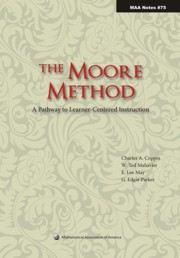Book contents
- Frontmatter
- Contents
- Dedication
- Acknowledgements
- 1 Introduction
- 2 Moore's Moore Method
- 3 What is the Moore Method?
- 4 On Culture
- 5 Development and Selection of Materials
- 6 In the Classroom
- 7 Grading
- 8 Why Use the Moore Method?
- 9 Evaluation and Assessment: Effectiveness of the Method
- 10 Frequently Asked Questions
- Appendices
- About the Authors
- References
- Index
9 - Evaluation and Assessment: Effectiveness of the Method
- Frontmatter
- Contents
- Dedication
- Acknowledgements
- 1 Introduction
- 2 Moore's Moore Method
- 3 What is the Moore Method?
- 4 On Culture
- 5 Development and Selection of Materials
- 6 In the Classroom
- 7 Grading
- 8 Why Use the Moore Method?
- 9 Evaluation and Assessment: Effectiveness of the Method
- 10 Frequently Asked Questions
- Appendices
- About the Authors
- References
- Index
Summary
“All the instruments have been tried save one, the only one precisely that can succeed: well-regulated freedom.”
—Jean-Jacques RousseauIn this chapter, we discuss the results of educational research that has been conducted evaluating the impact of the Moore Method and describe the results of educational research on similar teaching approaches, draw parallels to the Moore Method, and make suggestions for further assessment of the effectiveness of the Moore Method for interested readers.
Introduction
Whenever an innovation emerges in teaching, there are important questions to be asked. Does the innovation actually work? That is, does it truly improve students' learning, or does it just give the appearance of doing so? Is it feasible that the innovation can be implemented by other instructors in other educational settings, or does it rely upon the talent of a few gifted instructors in a particular context? Is the innovation appropriate for all learners, or just for a particular subgroup? Though the proponents of such innovations are often quite enthusiastic in their efforts to describe and promote the innovation, they are often only able to provide anecdotal evidence for its success. While important and frequently convincing, such evidence is not sufficient to answer the questions posed above. Rather, careful, systematic research should be done to establish the effectiveness of the innovation.
- Type
- Chapter
- Information
- The Moore MethodA Pathway to Learner-Centered Instruction, pp. 139 - 150Publisher: Mathematical Association of AmericaPrint publication year: 2009

